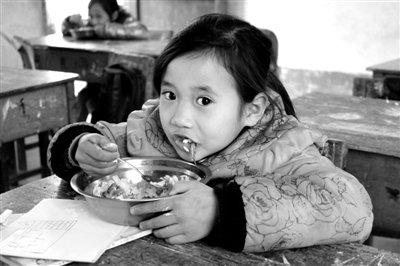
A schoolgirl is having lunch in Napo County on March 13, 2012. It was reported that some schools there were buying "Zhuangzhuang Buffalo Milk" for the Free Lunch program, and that suppliers earned 1 yuan from a subsidy of 3 yuan for each serving of the milk.
(Ecns.cn) – The Free Lunch Fund, a well-known charity operated by the China Social Welfare Foundation, issued an annual financial report for 2011 at the anniversary celebration of the "Free Lunch for Children" program held on Sunday, according to the Beijing Times.
According to the report, the fund has received about 18 million yuan (US$2.86 million) in donations since it started on April 2 last year, and has managed to provide free lunches for about 15,000 children in 129 schools across China.
Initiated by the foundation and more than 500 journalists, the Free Lunch Fund has gained support nationwide and its financial reportage has been praised by the public for its detail. However, some problems have also been recently exposed.
Expenses too low?
Operational spending by charities has become the focus of much public attention in China in recent years, with many people expressing doubts that donated money is being properly used.
As a result, the Free Lunch Fund has developed an unusual fundraising method by running an online shop on China's largest B2C platform, Taobao.com. There, millions of people have donated by buying inexpensive "virtual charity products," T-shirts and pins.
The public can also check daily reports from schools on the program's official microblog. Every school sponsored by the program has been asked to set up a microblog to publicize the funds it receives and how the money is spent, noted the Beijing News.
By using social networks, the Free Lunch Fund has gradually established trust with the public. Deng Fei, a reporter from the Phoenix Weekly magazine and now a member of the project's management board, revealed that many people volunteer for the program and that even members of the management board run the project for free.
According to its financial report, the Free Lunch Fund spent 3.47 million yuan (US$550,000) in 2011, but operational spending accounted for only 3 percent of the total expenses.
This is surprising, said Wang Zhenyao, director of the One Foundation Philanthropy Research Institute at Beijing Normal University, who warned that such a low percentage of operational spending will not be good for the development of the program in the long run.
A large number of volunteers in the program may be able to afford expenses for meals, business trips and communication on their own, but these should be reimbursed by the Free Lunch Fund, noted Wang.
It is impossible for them volunteer for a lifetime, and such costs should be calculated, added Wang, saying it is acceptable as long as the administrative costs are kept below 10 percent of the total expenses.
Meager profits criticized
Earlier this month, it was reported that lunches served to schoolchildren in Napo County of South China's Guangxi Zhuang Autonomous Region cost less than 3 yuan apiece, which suggested that product suppliers might have made a small profit from every set meal.
According to the Beijing News, some schools in Napo County were buying "Zhuangzhuang Buffalo Milk" for the Free Lunch program, and that suppliers earned 1 yuan from a subsidy of 3 yuan for each serving of the milk.
Li Zhongming, headmaster of a local primary school, said different suppliers always contact him whenever the school receives subsidies from the government.
On March 12, the school received a new subsidy, which Li planned to use to provide breakfast for the boarders, since the students were already enjoying free lunches and dinners. Li looked up "Zhuangzhuang Buffalo Milk" and decided that it was a balanced source of nutrition, so he agreed to let the brand's local supplier offer its products for a semester.
A week later, 242 students at the school began enjoying buffalo milk for breakfast. However, Li soon began having second thoughts, and decided that the milk alone was not sufficient for the children's breakfast, so he followed the example of other schools and began offering each student a 2-yuan portion of yogurt and a 1-yuan bun.
The milk supplier was eager keep the school's business, however, and soon offered Li kickbacks if he agreed to continue with the original plan, but the headmaster refused.
After that, Li realized that many foods paid for by the Free Lunch program cost less than 3 yuan for each set meal, and that suppliers were profiting from the business. This set off criticism from Web users, who blamed the food suppliers for their lack of conscience and argued that people should not earn any money from charity.
Yet the fact is that the food suppliers are earning such small profits from the subsidies that they are having a hard time even paying their employees.
In a county-level school in Qinghai Province, children enjoy free snacks every day that cost less than 1 yuan apiece. The company that makes the snacks earns a very small profit by providing them to the schools, and the income of the company's employees is at a very low level, reported China Youth Daily.
Even the suppliers of "Zhuangzhuang Buffalo Milk" must take the costs of transportation and personnel into consideration.

Copyright ©1999-2011 Chinanews.com. All rights reserved.
Reproduction in whole or in part without permission is prohibited.